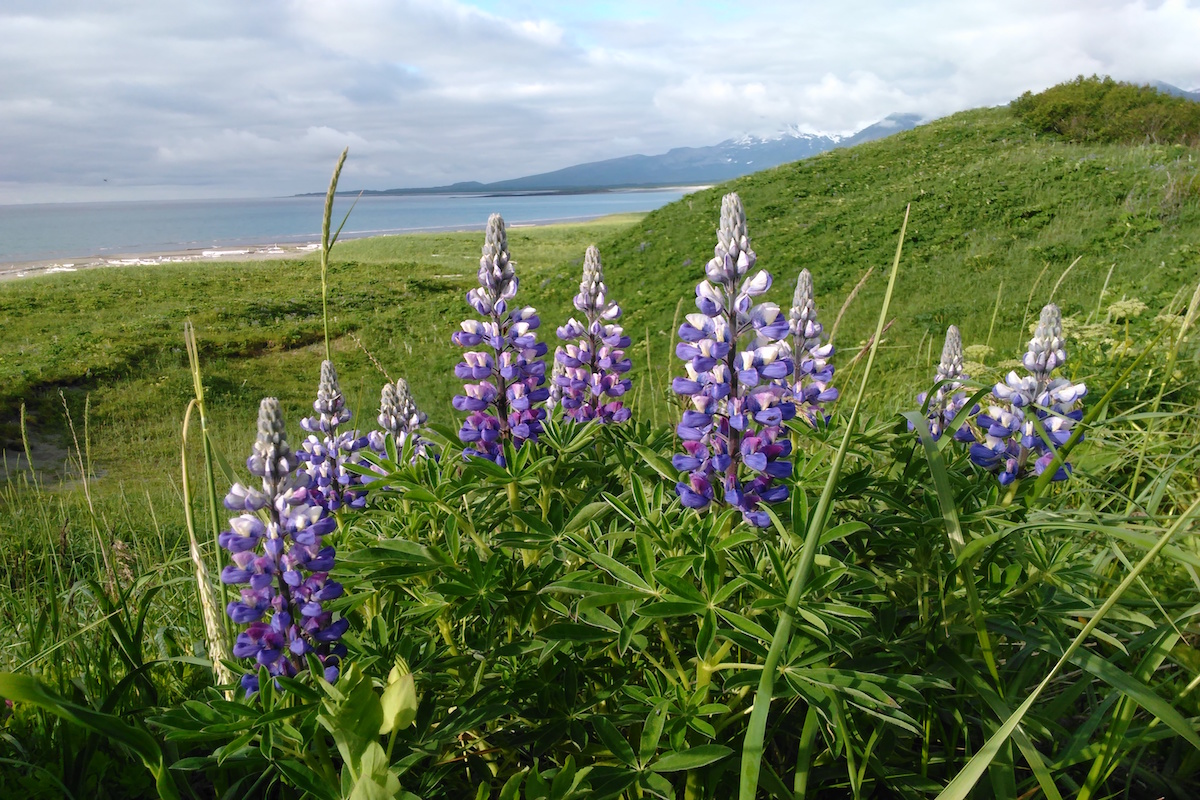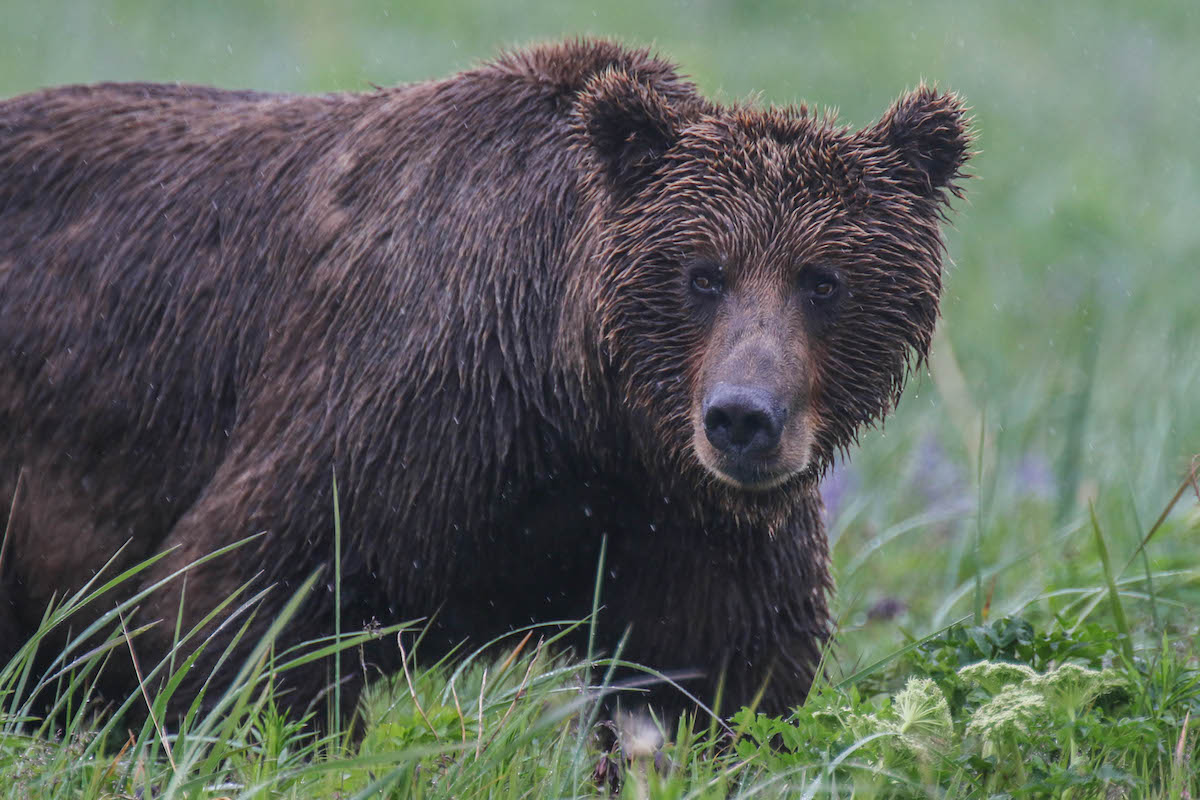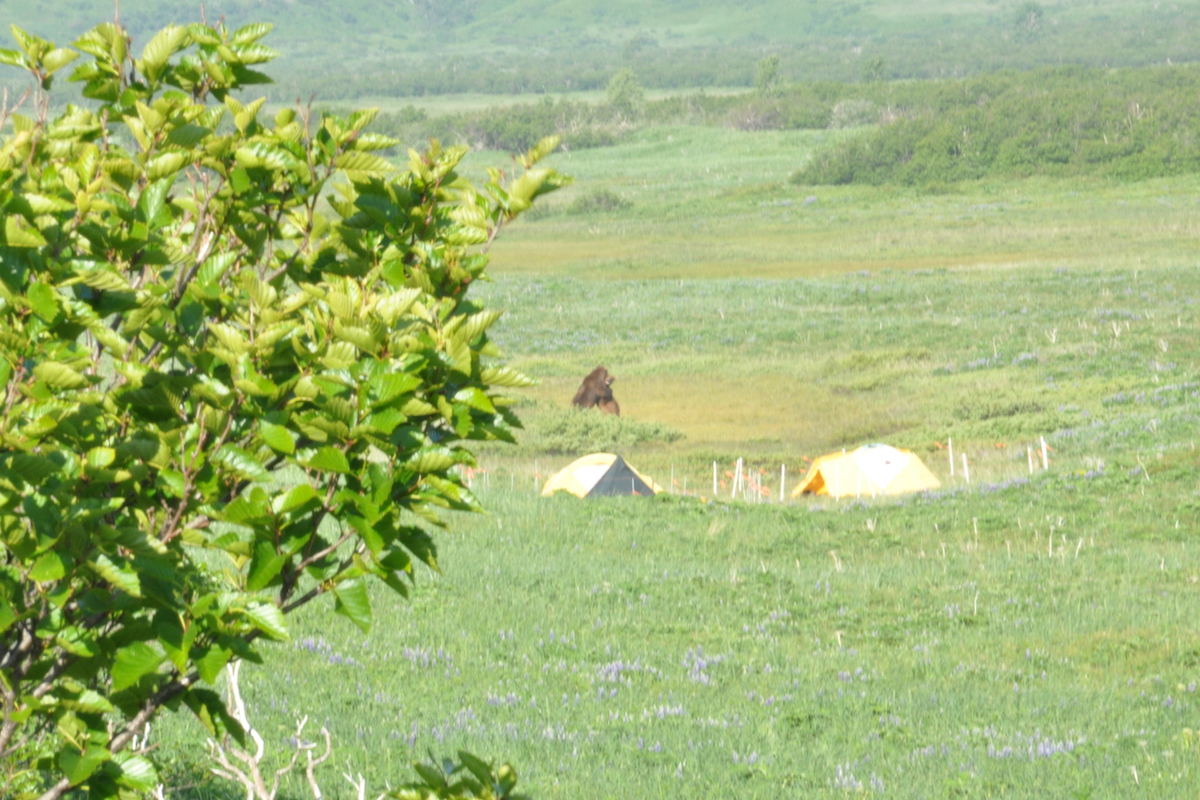“Oh no, don’t run! Poor little guy,” researcher Joy Erlenbach intones quietly.
It is worth noting that the little guy in question is a brown bear that appears at a distance like he could be twice my size, at least to my untrained eyes. But as I watch him bound away a bit clumsily, I do find myself feeling a note of empathy for the bear. He is a subadult, a gangly teenager in the world of bears. He is in an area in which there are several males that are older and larger about. He must be wary as he moves along the coast looking for food. Then, when he thinks he has found a safe spot to eat, a couple of humans enter his bubble, sending him away nervously again.
What is notable is that he is fleeing us at a distance of about 200 yards, separated from us by a large lagoon. This is not typical behavior for bears around Brooks Camp. Nor is it even necessarily typical for coastal bears. It is certainly not the reaction people expect from such a powerful animal. But spend some time among them, and you begin to realize that bears are more varied and complex than one might suspect.
 Lupine blooms near the coast of Cape Douglas. NPS Photo/C. Augustson.
Lupine blooms near the coast of Cape Douglas. NPS Photo/C. Augustson.
I learn this rapidly as I spend time observing bears with Joy at Cape Douglas. This is a less known section of Katmai’s wild coastline, a hidden gem in a region flush with barely seen wonders. Here the crashing surge of the sea is separated from glacial-cut peaks by wide swaths of open fields erupting with wildflowers. Beach pea, lupine, cow parsnip, chocolate lilies, and yarrow dot green fields profusely. Those who do come here are possibly more likely to note what else dots the fields: bears. Joy is observing bear behavior along the coast as a part of the complex Changing Tides Project, which is studying the links between coastal brown bears, marine resources like the intertidal invertebrates they sometimes feed on, and the humans that frequent these environments. By the time I arrive, she has already been in the field for twenty-one days at two other sites. This one is notable for being less visited, and some of the bears are shyer here, giving us a wide berth.
Well, some of them are, at any rate. Others don’t seem to mind us at all, to the point where you could almost call them showmen.
 A young bear (“Charlie”) rolls in the grass in the middle of a long day of grazing on nutritious sedges. NPS Photo/M. Bradburn.
A young bear (“Charlie”) rolls in the grass in the middle of a long day of grazing on nutritious sedges. NPS Photo/M. Bradburn.
This is where I introduce the bears that became the celebrities of the trip. There were two young adult males that were quite comfortable occupying the same field as our tents. In the ten days we were there, they could often be found grazing on sedge, napping, or even wrestling within view. One was smaller, with a bright reddish brown coat. The other was larger, with dark chocolate fur. The park strives to avoid naming bears, in recognition of their wild nature, yet sometimes nicknames are inevitable when you get to know a certain animals. In striving for nicknames, Joy came up with Charlie for the former, and Vlad for the latter. “They just seem right,” she replies when asked about their origins. The names stick almost immediately. Maybe it’s a trick of the imagination, but they DO seem fitting. Charlie is immediately the charismatic one, a bolt of energy, while Vlad seems somewhat slower, plodding and calm. When we watch them wrestle, batting paws and tumbling over one another, Charlie seems to have the edge in spite of his smaller stature. Vlad could easily overpower him, but he seems content to yield ground and roll over in the grass.
Two bears wrestle near camp. NPS Photo/C. Augustson.
I become somewhat better acquainted with these two as time progresses. One morning, while I was sitting on a bucket contemplatively (as one is wont to do when there is no outhouse at a convenient distance) I looked casually to the side and very nearly fell over. The two bears were gamboling up the hill I was perched on, apparently oblivious to my presence. After begging under my breath for them to move elsewhere, I elected instead to move away. And so I awkwardly clambered down the hill to what I considered a significant distance. But I was forced to move my bucket and myself a second time, cursing internally, when the larger of the two just so happened to show up again (surprisingly quietly) far too close for comfort. I attempted to move again, only to see that my path was blocked in the distance by three unrelated bears. It was possibly the most stressful version of my morning routine ever. All this before coffee.
Katmai has an awful lot of bears, is what I am trying to say here.
A similar moment of comedy arose later that day. While we were some distance away on the ridge scanning the shore for bear activity, we turned towards camp to witness the larger bear moving towards our tents. This was concerning. Our food and strong-smelling items were sealed away in bear barrels, but you never want a bear to break into camp. We watched to see if our electric fence would be enough to ward him off. Charlie approached in a way that could only be described as “furtive.” Joy laughed about it later. Casually nibbling on grass, the bear got closer to the colorful tents slowly, undeniably cautiously. He feigned disinterest with his body language, but got closer bit by bit all the same. Finally he was close enough to nose the electric wire surrounding camp. Bears have a habit of studying the world through their nose, you see. We wait in anticipation of a dramatic response.
The reaction was what you could call “subdued.” Charlie jerked his head back as he received a jolt, and proceeded to stare unmoving at the fence. Then, slowly, calmly, he began to walk away. But we had to note that he turned and stared three times before he finally moved on. “It’s like he was thinking ‘What on Earth was THAT about? I don’t know if I liked it…’” Joy exclaimed, delighted that the fence had worked so well.
Another encounter passes without incident many days later. As our team returned to camp after a rather rainy morning, we saw the two bears approach our area again, getting within ten yards of the fence. We spoke softly to the bears and snapped a deluge of photos, but prepared to raise our voices or sound an air horn if they came any closer. The two bears sniffed the air and watched us curiously, and then moved on.

A large male (“Vlad”) watches camp curiously while crossing the field in the rain. NPS Photo/M. Bradburn.
Joy notes that “People need to see how the bears act around us out here. They need to know that it is possible to have these incredible experiences.”
It is clear that Joy loves these animals, and it is easy to see why. Spend any time around bears, and you begin to see personalities emerge. You can begin to read their body language, see tiny hints of their largely unknown inner lives. The work she carries out on the coast is striving to better understand their behavior, to know which foods are most important to bears before the salmon arrive, and to learn how park managers can better protect the resources they need. Learn more about this research on the park’s “Changing Tides” page.
I was fascinated by the bears of the coast during my stay at Cape Douglas. To the subadult that ran away from us earlier, we were viewed as a threat. To the two that moved comfortably around our camp, we were a curiosity. From most of the rest of the bears we witnessed, we evoked almost no response at all. I find myself wondering if these are behavioral patterns learned or ingrained traits. There is much research left to be done on the activities of even the most-known and charismatic animals. I suspect that there is more to these giants than meets the eye, and that exciting new research questions will emerge as we ponder their quests for the bear necessities of life.

